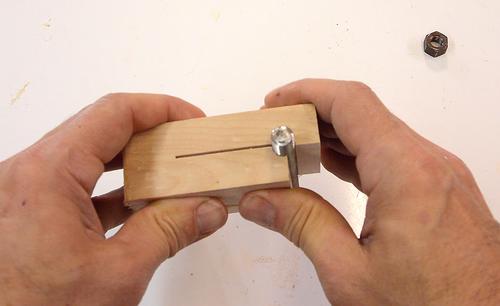 You can use metal thread taps for wood just fine, but I wanted to experiment with
making my own from a piece of threaded rod.
You can use metal thread taps for wood just fine, but I wanted to experiment with
making my own from a piece of threaded rod.
 You can use metal thread taps for wood just fine, but I wanted to experiment with
making my own from a piece of threaded rod.
You can use metal thread taps for wood just fine, but I wanted to experiment with
making my own from a piece of threaded rod.
I started by making a "jig" to hold the threaded rod for grinding slots in it.
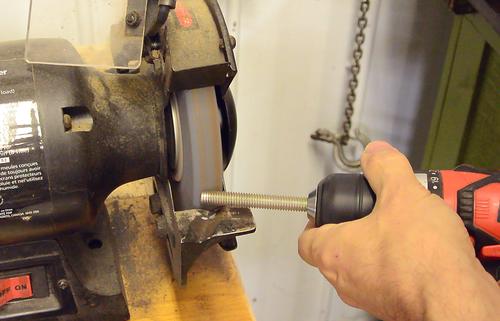 But before cutting slots in the threaded rod, I cut a slight taper in the end of it.
That way the thread will be cut over the course of several turns instead of just
by the very tip.
But before cutting slots in the threaded rod, I cut a slight taper in the end of it.
That way the thread will be cut over the course of several turns instead of just
by the very tip.
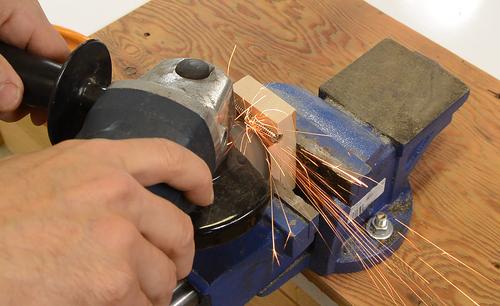 I then used my jig to clamp the threaded rod in the vise. The jig itself
serves as a guide for a cut-off disk in an angle grinder to cut the slots
in the threaded rod.
I then used my jig to clamp the threaded rod in the vise. The jig itself
serves as a guide for a cut-off disk in an angle grinder to cut the slots
in the threaded rod.
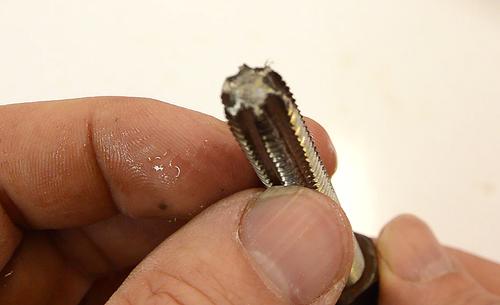 I cut a total of six slots in the threaded rod. I used two hex nuts jammed against
each other on the threaded rod to guide how much to turn it by to space the
slots. Spacing four slots evenly would have been more tricky unless I found
a square nut to fit on the threaded rod (or I suppose, I could have jammed a square
piece of wood between the two nuts as a guide)
I cut a total of six slots in the threaded rod. I used two hex nuts jammed against
each other on the threaded rod to guide how much to turn it by to space the
slots. Spacing four slots evenly would have been more tricky unless I found
a square nut to fit on the threaded rod (or I suppose, I could have jammed a square
piece of wood between the two nuts as a guide)
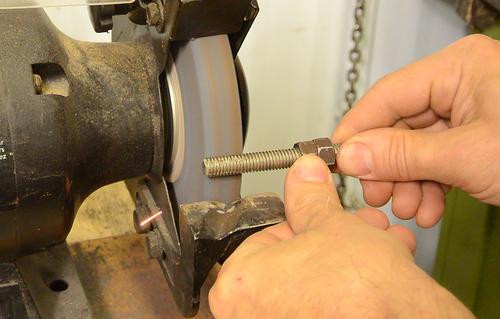 I ground three flat spots onto the other end of the threaded rod to make it easier
to grab it in a drill chuck. Again, I used two-nuts as a visual guide to help me space
the three flat spots evenly.
I ground three flat spots onto the other end of the threaded rod to make it easier
to grab it in a drill chuck. Again, I used two-nuts as a visual guide to help me space
the three flat spots evenly.
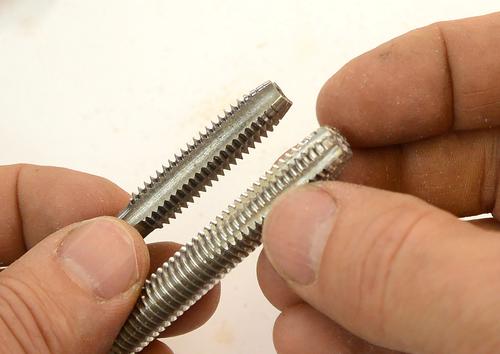 Home made thread tap next to a proper metal thread tap.
Home made thread tap next to a proper metal thread tap.
The metal one works just fine in wood (and metal). Interestingly, the metal tap is slightly bigger than the one I made. When threading holes in metal, the hole needs to be slightly bigger than the bolt or threaded rod that screws into it, or it will get stuck. With wood, having a hole slightly smaller is not a problem because the wood has some flexibility. That's how wood screws engage.
The homemade tap cuts the thread with just the first few turns so it can cut threads closer to the bottom of a blind hole. I could just make another one with no taper at all to cut threads all the way to the bottom of a hole. That's the nice thing about homemade tools — infinitely customizable.
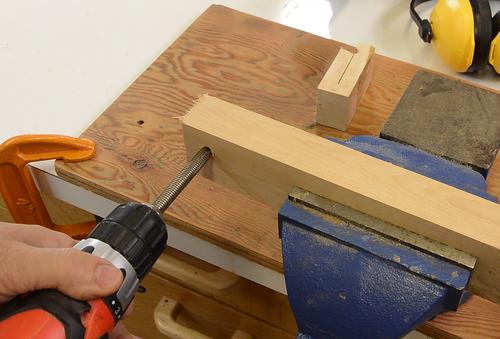 Testing it out. Worked well. Though, in retrospect, I should have cut the flutes
slightly larger because they had a tendency to get filled with sawdust.
Drilling a larger hole before tapping would also help.
Testing it out. Worked well. Though, in retrospect, I should have cut the flutes
slightly larger because they had a tendency to get filled with sawdust.
Drilling a larger hole before tapping would also help.
It was easy to screw a threaded rod into the resulting hole just by turning it with my fingers.
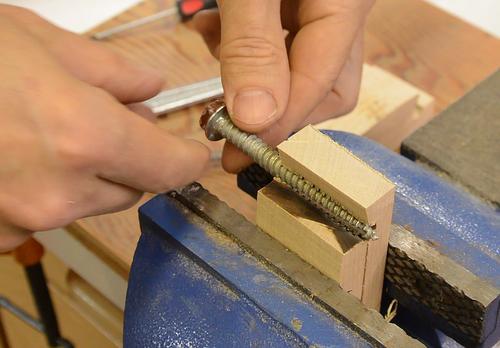 Then trying the same method with a wood bolt, which has much coarser threads.
Then trying the same method with a wood bolt, which has much coarser threads.
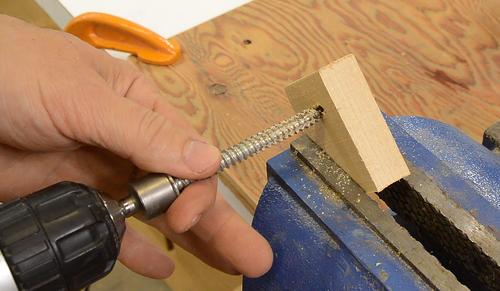 I cut wider flutes in this one so I didn't have to back it out half-way
to clear the chips.
I cut wider flutes in this one so I didn't have to back it out half-way
to clear the chips.
I figure this could be a handy alternative to using a machine screw and threaded insert for some adjustment knob or fastening knob on a homemade machine. With so much wood between the threads, it's very unlikely that the threads would wear out.
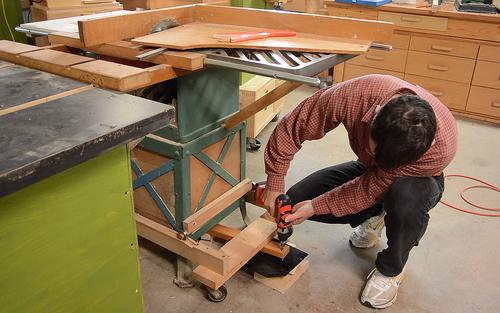 I did a quick wear test, screwing the screw in and out many times while pushing
hard against the drill. Then I had the idea of setting it up to use the screw to lift
my table saw. Again, up and down many times, no sign of wear.
I did a quick wear test, screwing the screw in and out many times while pushing
hard against the drill. Then I had the idea of setting it up to use the screw to lift
my table saw. Again, up and down many times, no sign of wear.
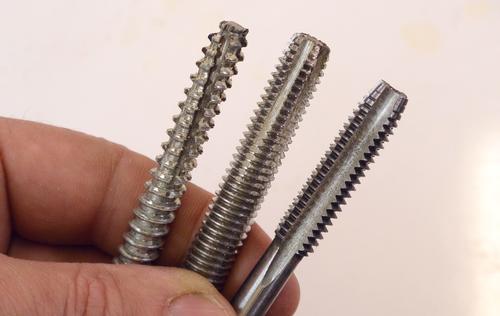
I figure these coarse threads could be handy for something where a cover needs to be held
in place. If I make wooden knobs for the wood bolts, that will make for a cheap and
easy way to make threaded knobs to hold a cover onto something.
I am using a piece of oak here. Soft woods like pine or spruce would not hold up as well.
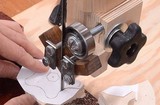 Making bandsaw blade guides (2016)
Making bandsaw blade guides (2016)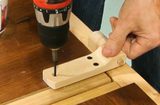 Making wooden hinges (2013)
Making wooden hinges (2013) Basement bookcase (2017)
Basement bookcase (2017)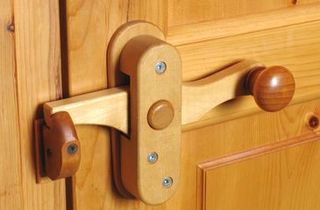 Dad's wooden door
Dad's wooden door